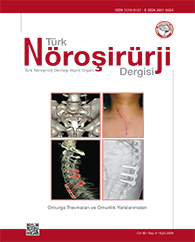Türk Nöroşirürji Dergisi
2020 , Vol 30 , Num 3
Treatment Approaches for Lower Lumbar Spine (L4 - L5) Fractures: Conservative Treatment / Surgical Treatment - Indications and Methods
1Hitit Üniversitesi Tıp Fakültesi, Beyin ve Sinir Cerrahisi Anabilim Dalı, Çorum, Türkiye
Lower lumbar (L4 and L5) spine fractures are relatively rare compared to the other spinal regions and may occur after trauma,
osteoporosis or metastasis. The injuries of this region may differ from other spinal injuries in terms of the clinical and morphological
aspects as well as treatment approaches. The most significant indicator of treatment in lower lumbar spine fractures is the mechanical
stability, and hence its potential of resulting in neural injury. To determine the ideal treatment approaches for the appropriate
patients, several classification and scoring systems have been suggested to date. Of these, the most frequently used ones are
the Denis, McAfee, Thoracolumbar Injury Classification and Severity Score (TLICS), and AOSpine Thoracolumbar Classification
systems. Generally, surgery should be preferred in cases with lower lumbar spine fractures that are unstable or lead to progressive
deformities of angulation or neurological deficits. In surgical treatment, transpedicular stabilization through a posterior approach
is usually carried out although this can be combined with an anterior or lateral approach in cases that require corpectomy. For the
injuries that do not meet the criteria of surgery, conservative treatment consisting of the appropriate analgesics, appropriate bed
rest duration, and if needed, external immobilization (bracing) during mobilization should be utilized.
Anahtar Kelimeler :
Lumbar spine fractures, Surgical treatment, Conservative treatment, Spinal injury

